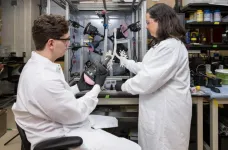(Press-News.org) A research team led by Rumi Chunara - an NYU associate professor with appointments in both the Tandon School of Engineering and the School of Global Public Health – has unveiled a new artificial intelligence (AI) system that uses satellite imagery to track urban green spaces more accurately than prior methods, critical to ensuring healthy cities.
To validate their approach, the researchers tested the system in Karachi, Pakistan's largest city where several team members are based. Karachi proved an ideal test case with its mix of dense urban areas and varying vegetation conditions.
Accepted for publication by the ACM Journal on Computing and Sustainable Societies, the team’s analysis exposed a stark environmental divide: some areas enjoy tree-lined streets while many neighborhoods have almost no vegetation at all.
Cities have long struggled to track their green spaces precisely, from parks to individual street trees, with traditional satellite analysis missing up to about 37% of urban vegetation.
As cities face climate change and rapid urbanization, especially in Asia and Africa, accurate measurement has become vital. Green spaces can help reduce urban temperatures, filter air pollution, and provide essential spaces for exercise and mental health.
But these benefits may be unequally distributed. Low-income areas often lack vegetation, making them hotter and more polluted than tree-lined wealthy neighborhoods.
The research team developed their solution by enhancing AI segmentation architectures, such as DeepLabV3+. Using high-resolution satellite imagery from Google Earth, they trained the system by augmenting their training data to include varied versions of green vegetation under different lighting and seasonal conditions - a process they call 'green augmentation.' This technique improved vegetation detection accuracy by 13.4% compared to existing AI methods - a significant advance in the field.
When measuring how often the system correctly identifies vegetation, it achieved 89.4% accuracy with 90.6% reliability, substantially better than traditional methods which only achieve 63.3% accuracy with 64.0% reliability.
"Previous methods relied on simple light wavelength measurements," said Chunara, who serves as the Director of the NYU Center for Health Data Science and is a member of NYU Tandon’s Visualization Imaging and Data Analysis Center (VIDA). "Our system learns to recognize more subtle patterns that distinguish trees from grass, even in challenging urban environments. This type of data is necessary for urban planners to identify neighborhoods that lack vegetation so they can develop new green spaces that will deliver the most benefits possible. Without accurate mapping, cities cannot address disparities effectively."
The Karachi analysis found the city averages just 4.17 square meters of green space per person, less than half the World Health Organization's (WHO’s) recommended minimum of 9 square meters per capita. The disparity within neighborhoods is dramatic: while some outlying union councils – Pakistan’s smallest local government body, a total of 173 were included in the study – have more than 80 square meters per person, five union councils have less than 0.1 square meters per capita.
The study revealed that areas with more paved roads – typically a marker of economic development – tend to have more trees and grass. More significantly, in eight different union councils studied, areas with more vegetation showed markedly lower surface temperatures, demonstrating green spaces' role in cooling cities.
Singapore offers a contrast, showing what's possible with deliberate planning. Despite having a similar population density to Karachi, it provides 9.9 square meters of green space per person, exceeding the WHO target.
The researchers have made their methodology public, though applying it to other cities would require retraining the system on local satellite imagery.
This study adds to Chunara’s body of work developing computational and statistical methods, including data mining and machine learning, to understand social determinants of health and health disparities. Prior studies include using social media posts to map neighborhood-level systemic racism and homophobia and assess their mental health impact, as well as analyzing electronic health records to understand telemedicine access disparities during COVID-19.
In addition to Chunara, the paper’s authors are Miao Zhang, a PhD candidate in NYU Tandon’s Department of Computer Science and Engineering and VIDA; and Hajra Arshad, Manzar Abbas, Hamzah Jehanzeb, Izza Tahir, Javerya Hassan and Zainab Samad from The Aga Khan University's Department of Medicine in Karachi. Samad also holds an appointment in The Aga Khan University’s CITRIC Health Data Science Center.
Funding for the study was provided by the National Science Foundation and National Institutes of Health.
END
New AI system accurately maps urban green spaces, exposing environmental divides
Team led by NYU’s Rumi Chunara uses satellite imagery and deep learning to reveal stark disparities in Karachi's green spaces, offering cities better tools to track and plan vital cooling spaces
2025-02-20
ELSE PRESS RELEASES FROM THIS DATE:
Gordon Keller receives the 2025 ISSCR Achievement Award for his seminal work in regenerative medicine
2025-02-20
The International Society for Stem Cell Research (ISSCR) is honoring Gordon Keller, Ph.D., with this year’s ISSCR Achievement Award. Dr. Keller is the Director of the McEwen Stem Cell Institute at the University Health Network (UHN) in Toronto, Canada. He will present his research at the ISSCR 2025 Annual Meeting taking place in Hong Kong 11-14 June 2025.
“Gordon Keller's groundbreaking work in regenerative medicine has illuminated the path to transforming human health,” said Andrea Ditadi, Group Leader, San Raffaele Telethon Institute for Gene Therapy (SR-TIGET), Italy, who led the nomination of Dr. Keller. “From ...
Yonatan Stelzer earns the 2025 ISSCR Outstanding Young Investigator Award for his breakthrough approaches to addressing fundamental problems in mammalian development
2025-02-20
The International Society for Stem Cell Research (ISSCR) is honoring Yonatan Stelzer, Ph.D. with the 2025 ISSCR Outstanding Young Investigator Award. Dr. Selzer is an associate professor in the Department of Molecular Cell Biology at the Weizmann Institute of Science, Israel.
The award recognizes the exceptional achievements of an investigator in the early part of his or her independent career in stem cell research. Dr. Stelzer will present his work at the ISSCR 2025 Annual Meeting taking place in Hong Kong 11-14 June 2025.
“Yonatan Stelzer’s innovative approach to real-time, single-cell ...
Ivermectin, hydroxychloroquine prescriptions during the COVID-19 pandemic soared far above pre-pandemic levels
2025-02-20
U.S. outpatient prescriptions for hydroxychloroquine and ivermectin increased 2- to 10-fold above pre-pandemic rates, respectively, to treat COVID-19, despite strong evidence disproving their effectiveness, new UCLA-led research shows.
Nearly three million COVID-related prescriptions were issued in the three and a half years between January 30, 2020 and June 30, 2023, totaling $272 million in estimated spending. Usage was three times higher among adults aged 65 and older compared with those aged 18 to 64. Ivermectin use in particular was higher among people living in the most socially vulnerable neighborhoods and markedly higher in the Southern ...
3D lung model raises the bar for research
2025-02-20
Respiratory diseases are a challenging problem to treat. Inhalable medicines are a promising solution that depend on the ability to deliver tiny particles known as aerosols to the correct location in the lungs at the correct dosage.
How effectively this works can get complicated, depending on the drug, delivery method and patient. This is because it is difficult to predict just how much medicine gets in and where it goes in the lung. Similar challenges exist when thinking about measuring an ...
Lehigh Engineering faculty named Senior Members of the National Academy of Inventors
2025-02-20
Six Lehigh University professors have been named Senior Members of the National Academy of Inventors. The 2025 cohort comprises 162 academic inventors representing 64 NAI Member Institutions across the United States. Collectively, they are named inventors on over 1200 U.S. patents.
“This year’s class comes from a multitude of impressive fields and research backgrounds from across the world,” said NAI President Paul R. Sanberg. “We applaud their pursuit of commercialization to ensure their groundbreaking technologies ...
Researchers outline new approach for better understanding animal consciousness
2025-02-20
A team of researchers has outlined a new approach for better understanding the depths of animal consciousness, a method that may yield new insights into the similarities and differences among living organisms.
The essay, which appears in the journal Science, describes a “marker method” that scientists can use to assess animal consciousness. It involves identifying behavioral and anatomical features associated with conscious processing in humans and searching for similar properties in nonhumans. By making progress in the science of animal consciousness, the authors propose, we can make progress on foundational questions about the nature of consciousness, ...
Bioinspired robot collectives that can act like solids or fluids on demand
2025-02-20
Inspired by the cooperation of cells in tissues, researchers have developed a robotic collective system capable of transitioning between rigid and solid structures that can also support hundreds of times its own weight. The advancement overcomes a core challenge in the development of so-called “robotic materials” – cohesive networks of individual robotic units that function as a single dynamic, adaptive structure. Realizing these systems presents a fundamental challenge: this “material” must at once be strong and stiff enough to support loads, ...
AI-assisted diagnosis for immunological disease
2025-02-20
A novel machine learning framework – Mal-ID – can decipher an individual’s immune system’s record of past infections and diseases, according to a new study, providing a powerful tool with the potential for diagnosing autoimmune disorders, viral infections, and vaccine responses with precision. Traditional clinical diagnostic methods for autoimmune diseases or other immunological pathologies tend to rely on a combination of physical examination, patient history, and various laboratory testing for cellular or molecular abnormalities – a lengthy process often complicated by initial misdiagnoses and ambiguous systems. These approaches make limited use of data from ...
A new approach for breaking plastic waste down to monomers
2025-02-20
Researchers have reported a method for breaking down commercial polymers like Plexiglass into monomers, a form more desirable for reuse. This could help alleviate the growing plastic waste stream. Most current plastic recycling methods rely on macroscopic mechanical shredding, cleaning and reprocessing. As a result, the properties degrade relative to the virgin polymer. Chemical decomposition to the original monomer would enable more thorough purification and then repolymerization to restore ideal performance. Here, Hyun Suk Wang and colleagues report the discovery that in dichlorobenzene solvent, violet light irradiation ...
High-performance computing at a crossroads
2025-02-20
High-performance computing (HPC) systems – advanced computing ensembles that harness deliver massive processing power – are used for a range of applications, and the demand for them has increased with the rise of generative artificial intelligence (AI). However, for both traditional uses and to advance the power of AI, technical advances in HPC are greatly needed, say Ewa Deelman and colleagues in a Policy Forum. “With international competition for leadership in computing intensifying, without a renewed commitment, ...
LAST 30 PRESS RELEASES:
What determines the fate of a T cell?
Candida auris: genetic process revealed which could be treatment target for deadly fungal disease
Groundbreaking discovery turns household plastic recycling into anti-cancer medication
Blocking a key inflammatory pathway improves liver structure and vascular function in cirrhosis, study finds
Continuous spread: Raccoon roundworm detected in nine European countries
HKUST Engineering researchers developed a novel photodetector to enhance the performance of on-chip light monitoring
Strategic river sensors could have forewarned of Texas Camp flood disaster
Drone sampling of whale breath reveals first evidence of potentially deadly virus in Arctic
Roman soldiers defending Hadrian’s Wall infected by parasites, study finds
Pinochet’s prisoners were tormented with music but still found solace in it, a new book reveals
Fertility remains high in rural Tanzania despite access to family planning
AI-assisted device can improve autism care access
Kinetic careers
Uncovering how parasitic plants avoid attacking themselves to improve crop resistance
Nanoparticle vaccine strategy could protect against Ebola and other deadly filoviruses
Study finds brain care score can predict risk of stroke across racial groups
Key lung immune cells can intensify allergic reactions
Do hormones explain why women experience more gut pain?
New materials conduct ions in solids as easily as in liquids
Breakthrough of the Year: Renewable energy begins to eclipse fossil fuel-based sources
LLM use is reshaping scientific enterprise by increasing output, reducing quality and more
Introducing LightGen, a chip for ultra-fast, ultra-efficient generative AI
Astronomers see fireworks from violent collisions around nearby star
ACC/AHA issue new guideline on managing congenital heart disease in adults
Cosmic crash caught on camera
Is talented youth nurtured the wrong way? New study shows: top performers develop differently than assumed
Ants: An untapped resource in the development of antibiotics?
Archaeologists use AI to create prehistoric video game
Mitochondria migrate toward the cell membrane in response to high glucose levels
Tiny viral switch offers hope against drug-resistant bacteria
[Press-News.org] New AI system accurately maps urban green spaces, exposing environmental dividesTeam led by NYU’s Rumi Chunara uses satellite imagery and deep learning to reveal stark disparities in Karachi's green spaces, offering cities better tools to track and plan vital cooling spaces


